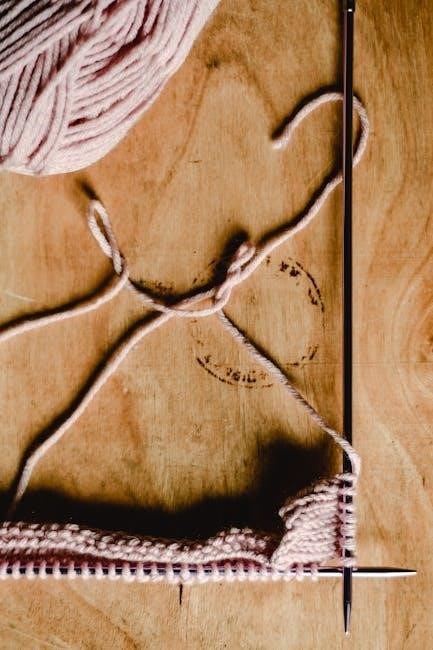
loom knit stitches pdf
Loom Knit Stitches PDF: A Comprehensive Guide
Loom knitting offers a relaxing and fun way to create various projects. A comprehensive guide, often available as a PDF, demystifies stitches, providing step-by-step instructions to master common techniques. These guides often include basic stitches and inspiration for new stitch patterns.
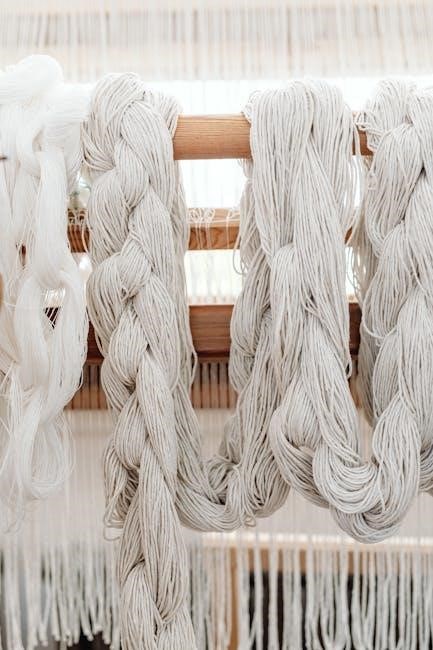
Loom knitting is a versatile and accessible craft, perfect for beginners and experienced crafters alike. Unlike traditional knitting with needles, loom knitting utilizes a frame with pegs to create various knit fabrics. This method simplifies the process, making it easier to learn and execute, especially for those with dexterity challenges. Looms come in different shapes and sizes, including round, rectangular, and long looms, each suited for different projects.
The basic principle involves looping yarn around the pegs and lifting the bottom loop over the top, creating a knit stitch. This technique can be used to produce a wide range of items, from hats and scarves to blankets and even socks. The availability of downloadable manuals in PDF format, such as those for Knifty Knitter looms, further enhances accessibility, providing clear instructions for casting on, basic stitches, and pattern work. Loom knitting opens up a world of creative possibilities, allowing crafters to explore different stitch patterns and color combinations to produce unique and personalized items. With its ease of use and wide range of applications, loom knitting is a rewarding and enjoyable hobby for crafters of all skill levels.
Basic Loom Knit Stitches and Techniques
Mastering basic loom knit stitches is crucial for any aspiring loom knitter. The foundation of loom knitting lies in understanding the knit stitch, often referred to as the flat stitch or U-stitch. This involves wrapping yarn around a peg and then lifting the bottom loop over the top, creating a new stitch. Another essential technique is casting on, which secures the yarn onto the loom to begin the knitting process. Similarly, casting off is used to remove the finished project from the loom, securing the final stitches.
Beyond the knit stitch, the purl stitch is another fundamental element, adding texture and dimension to projects. Techniques like single knitting, which involves working adjacent pegs, allow for creating flat panels or circular projects. Increasing and decreasing stitches are also vital for shaping projects, enabling the creation of more complex designs. Resources like the Good Knit Kisses exclusive How to Loom Knit PDF provide comprehensive lessons on these basics, including patterns for practice. By mastering these basic stitches and techniques, loom knitters can confidently embark on a wide array of projects, building a solid foundation for more advanced skills.
Knit Stitch Variations
Once the basic knit stitch is mastered, exploring knit stitch variations unlocks a world of creative possibilities in loom knitting. One popular variation is the twisted knit stitch, which adds a unique texture to the fabric. This stitch involves twisting the loop on the peg before knitting it off, creating a tighter, more defined stitch. Different methods of twisting can produce varying textures, allowing for customized designs.
Another intriguing variation is the e-wrap knit stitch, where the yarn is wrapped around the peg in a specific way to create a looser, more open fabric. Combining these variations with the standard knit stitch allows for intricate patterns and textures. For instance, alternating rows of twisted knit stitch and regular knit stitch can create a ribbed effect. Experimentation with different knit stitch variations not only enhances the aesthetic appeal of loom-knitted projects but also provides a deeper understanding of how stitch manipulation affects the final fabric. Many free patterns online offer opportunities to practice these variations and further develop loom knitting skills.
Purl Stitch Techniques on a Loom
The purl stitch is a fundamental technique in loom knitting, essential for creating a variety of textures and patterns. Unlike the knit stitch, the purl stitch creates a raised horizontal ridge on the fabric’s surface. Mastering the purl stitch on a loom involves a slightly different process compared to needle knitting, requiring the yarn to be brought forward before looping it around the peg.
One common method involves using a knitting hook to grab the existing loop on the peg, bringing it forward, and then placing the working yarn behind the loop before pulling it through. This creates the purl stitch. Alternating knit and purl stitches in various sequences can produce ribbing, seed stitch, and other textured designs. For example, alternating one knit stitch and one purl stitch creates a simple ribbing pattern, while alternating rows of knit and purl stitches forms the garter stitch. Free PDF resources and video tutorials are available online to guide beginners through the process of learning and perfecting purl stitch techniques on a loom.
Ribbing Patterns in Loom Knitting
Ribbing patterns are a crucial element in loom knitting, providing elasticity and a snug fit to projects like cuffs, brims, and sock tops. These patterns are created by alternating knit and purl stitches in various sequences. The most common ribbing patterns are 1×1 ribbing (alternating one knit stitch and one purl stitch) and 2×2 ribbing (alternating two knit stitches and two purl stitches).
To execute ribbing on a loom, you need to be proficient in both the knit and purl stitches. For 1×1 ribbing, you would knit one stitch, then purl the next, repeating this sequence around the loom. For 2×2 ribbing, you would knit two stitches, then purl two stitches, repeating the sequence. The elasticity of ribbing comes from the way the knit and purl stitches pull against each other, creating a flexible fabric. There are also variations like the fisherman’s rib, which creates a thicker, more textured ribbing. Many free loom knitting patterns and PDF resources offer detailed instructions and visual aids for mastering different ribbing techniques, making it easier for beginners to create professional-looking ribbed edges on their projects.
Twisted Stitches on a Loom
Twisted stitches add texture and visual interest to loom knitting projects, creating a unique and sophisticated look. These stitches involve manipulating the order in which stitches are worked on the loom, resulting in a twisted appearance. The most common twisted stitch is the twisted knit stitch, where the loop is worked through the back loop instead of the front, creating a tighter, more defined stitch.
To execute a twisted knit stitch on a loom, you insert your hook into the back loop of the stitch on the peg, yarn over, and draw the loop through, just as you would with a regular knit stitch. This simple change in technique results in a twisted stitch that leans slightly to one side, creating a visually appealing texture. Twisted stitches can be used alone or in combination with other stitches to create intricate patterns. For example, you can alternate rows of twisted knit stitches with rows of regular knit stitches to create a subtle yet effective texture. Many loom knit stitch dictionaries and PDF resources include a variety of twisted stitch patterns, providing detailed instructions and visual aids for mastering these techniques. These resources often include patterns for hats, scarves, and other projects that showcase the beauty and versatility of twisted stitches.
Cable Stitches on a Loom
Cable stitches bring a dimension of depth and sophistication to loom knitting, mimicking the intricate braided appearance of traditional needle-knit cables. While loom knitting might seem limiting for such complex designs, clever techniques allow for achieving stunning cable effects. These techniques involve temporarily holding certain stitches while others are worked, then bringing the held stitches forward to create the cable twist.
To execute cable stitches on a loom, you’ll typically need a cable needle or a similar tool to hold the stitches. The process involves slipping a set number of stitches onto the cable needle, holding it in front or back of the work, knitting the next set of stitches on the loom, and then knitting the stitches from the cable needle. The placement of the cable needle (front or back) determines the direction of the cable twist. Loom knitting patterns and PDF resources dedicated to cable stitches offer detailed instructions and diagrams to guide you through the process. These resources often include patterns for cabled hats, scarves, and afghans, showcasing the stunning results achievable with loom-knitted cables. Experimenting with different cable patterns can add a touch of elegance and complexity to your loom knitting projects.
Lace Stitches on a Loom
Lace stitches introduce an airy and delicate quality to loom knitting, creating openwork designs that are both beautiful and intricate. While lace is often associated with fine needles and yarns, it’s entirely possible to achieve stunning lace effects on a knitting loom with the right techniques and patterns; Loom-knitted lace involves strategically creating openings in the fabric by decreasing stitches and then increasing them again to maintain the desired stitch count.
Yarn overs, where the yarn is wrapped around a peg to create a new stitch in the next row or round, are commonly used to form these openings. Combining yarn overs with knit stitches and purl stitches allows for a wide variety of lace patterns. Blocking, a process of wetting and shaping the finished piece, is particularly important for lace to fully open up the delicate patterns and reveal their intricate beauty. Many loom knitting patterns and PDF resources offer detailed instructions and charts for various lace stitches, from simple eyelet patterns to more complex designs. These resources often include patterns for lace scarves, shawls, and other delicate projects, showcasing the stunning results achievable with loom-knitted lace. Experimenting with different yarn weights and loom sizes can also alter the look and feel of the finished lace fabric.
Colorwork Stitches for Loom Knitting
Colorwork stitches add vibrant designs and patterns to loom knitting, enabling you to create colorful and eye-catching projects. Unlike single-color knitting, colorwork involves using two or more colors of yarn within the same row or round to create intricate motifs, stripes, or geometric patterns. Several techniques can be employed for colorwork on a loom, including the basic stripe patterns, mosaic knitting, and more advanced methods like fair isle.
Stripes are the simplest form of colorwork, involving alternating rows or rounds of different colors. Mosaic knitting uses slipped stitches to create patterns without having to carry multiple strands of yarn across the back of the work, making it a great option for beginners. Fair Isle, while more complex, allows for more intricate and detailed designs by carrying multiple colors across the back, although managing the tension of the floats is crucial to prevent puckering. When working with colorwork, it’s essential to choose yarns of similar weight and fiber content to ensure a consistent fabric. Loom knitting patterns and PDF resources often provide charts and instructions for various colorwork stitches, including tips for managing yarn and creating clean color changes. These resources can help you master colorwork techniques and create stunning, personalized loom-knitted projects.
Slipped Stitch Patterns
Slipped stitch patterns offer a unique way to add texture and visual interest to loom knitting projects. These patterns involve intentionally slipping certain stitches without working them, creating a variety of effects depending on how the stitches are slipped and the surrounding stitches are worked. The term “slipped” directly comes from needle knitting, where the stitch is moved from one needle to the other without being knitted or purled.
In loom knitting, slipping a stitch involves moving the loop from one peg to the adjacent peg without wrapping it with yarn. This technique can create elongated stitches, raised textures, or even colorwork effects when combined with different colored yarns. Slipped stitch patterns are relatively easy to execute on a loom, making them a great option for beginner to intermediate loom knitters looking to expand their stitch repertoire. Numerous free patterns and PDF resources are available online, providing step-by-step instructions and visual aids for various slipped stitch patterns. These resources often include directions for both flat panel and circular knitting, as well as tips for achieving the desired texture and appearance. Experimenting with different combinations of slipped and worked stitches can lead to the creation of unique and personalized fabric designs. Some patterns can create a dangling effect while others add depth.
Advanced Loom Knitting Techniques
Once you’ve mastered the basic loom knitting stitches and techniques, you can explore advanced methods to elevate your projects. These techniques often involve combining multiple stitch patterns, manipulating stitches in unconventional ways, and incorporating shaping and design elements for professional-looking results. One advanced technique is creating intricate cable patterns on a loom, which involves using a cable needle or tool to hold stitches while others are worked, resulting in a twisted and textured design.
Another advanced technique is intarsia and fair isle colorwork, allowing you to create complex color patterns and designs within your knitted fabric; This requires careful planning and execution to ensure that the colors are properly aligned and the yarn is managed effectively. Additionally, advanced loom knitters may explore techniques like short rows to create shaping and curves in their projects, allowing for more fitted garments and unique designs. Mastering these advanced techniques requires patience, practice, and a willingness to experiment. Online resources, including video tutorials and PDF guides, can provide valuable assistance in learning and perfecting these skills. By expanding your loom knitting knowledge and abilities, you can create stunning and intricate projects that showcase your creativity and craftsmanship. Many patterns that can be found online will help you practice and master these techniques.
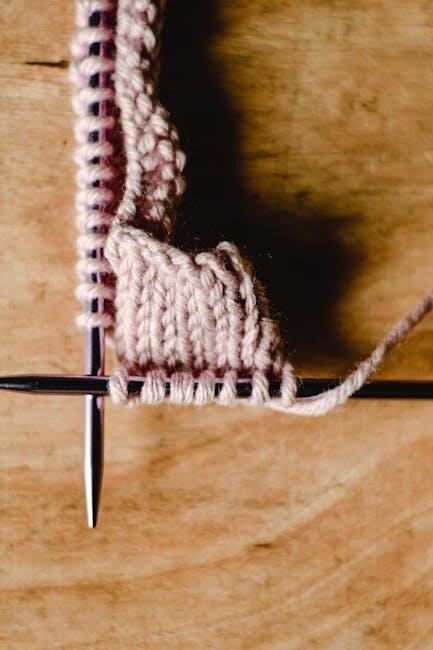
Free Loom Knitting Patterns and PDF Resources
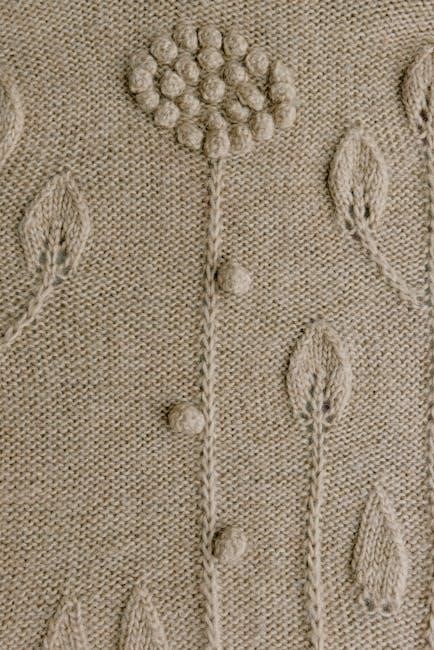
Numerous free loom knitting patterns and PDF resources are available online for both beginners and experienced loom knitters. These resources offer a wide variety of projects, from simple scarves and hats to more complex sweaters and afghans. Many websites and blogs dedicated to loom knitting provide downloadable PDF patterns with detailed instructions, step-by-step photos, and helpful tips. Some of these resources also include video tutorials that demonstrate the techniques used in the patterns.
For beginners, there are many simple patterns available that focus on basic stitches and techniques. These patterns are a great way to learn the fundamentals of loom knitting and build confidence. Experienced loom knitters can find more challenging patterns that incorporate advanced stitches, colorwork, and shaping. In addition to individual patterns, some websites offer comprehensive loom knitting guides and stitch dictionaries in PDF format. These resources can be invaluable for learning new stitches and techniques and for troubleshooting common problems. When searching for free loom knitting patterns and PDF resources, be sure to check the source’s credibility and read reviews from other knitters. Look for patterns that are well-written, easy to understand, and include clear photos or diagrams. With so many free resources available, you can easily find a project that suits your skill level and interests.
Troubleshooting Common Loom Knitting Issues
Even with the best instructions, loom knitters may encounter common issues during their projects. One frequent problem is dropped stitches, which can create holes or ladders in the fabric. This often happens when the yarn slips off the peg, and it’s crucial to catch it quickly to prevent further unraveling. Another common issue is uneven tension, resulting in a fabric that’s too tight or too loose. Maintaining consistent tension throughout the project is essential for a professional-looking result.
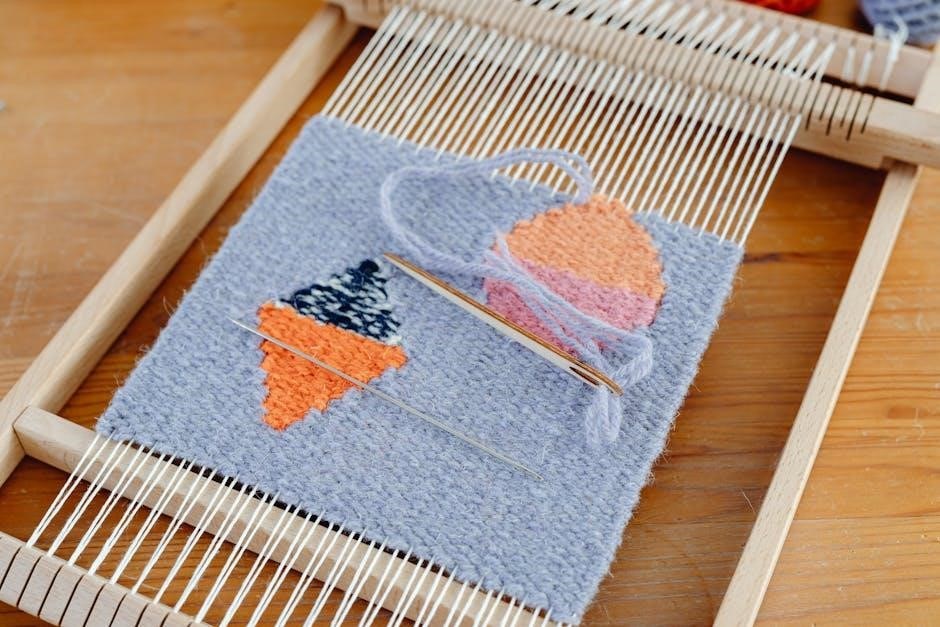
Yarn splitting can also be a challenge, especially with textured or multi-strand yarns. Using a yarn with a tighter twist or a different type of loom hook can help prevent this. Additionally, some knitters struggle with the cast-on or cast-off methods, which can result in a loose or too tight edge. Experimenting with different techniques and watching video tutorials can improve these skills. Finally, understanding how to fix mistakes without unraveling the entire project is invaluable. Using a crochet hook to pick up dropped stitches or correct errors can save a lot of time and frustration. Many online resources, including loom knitting forums and video tutorials, offer helpful tips and solutions for troubleshooting these common issues. By learning how to identify and address these problems, loom knitters can create beautiful and successful projects.


Leave a Reply
You must be logged in to post a comment.